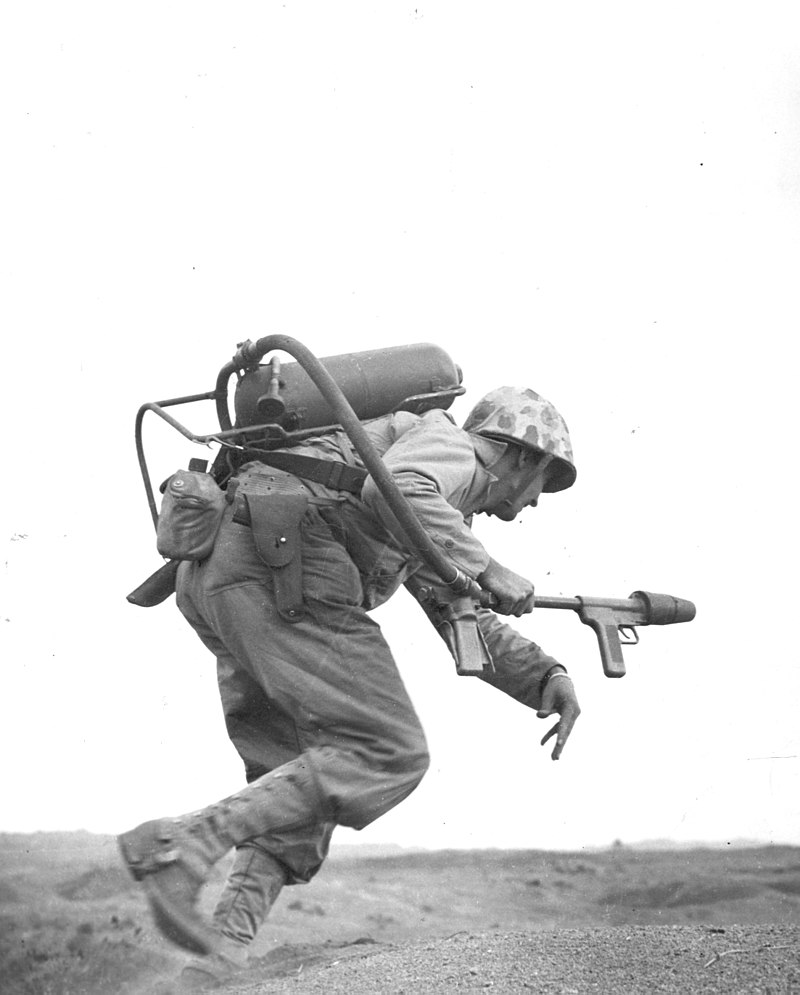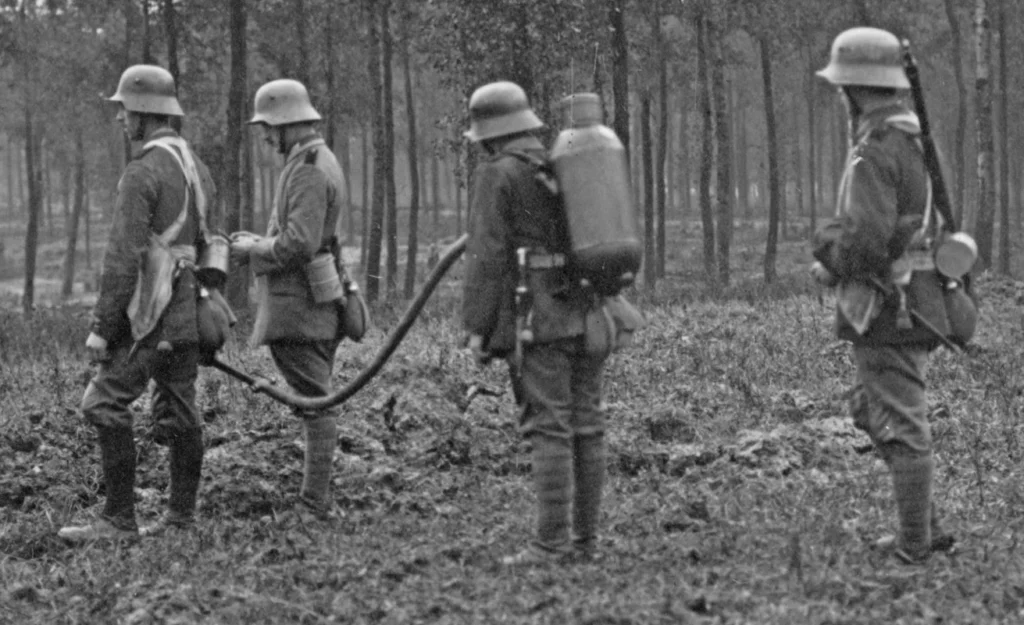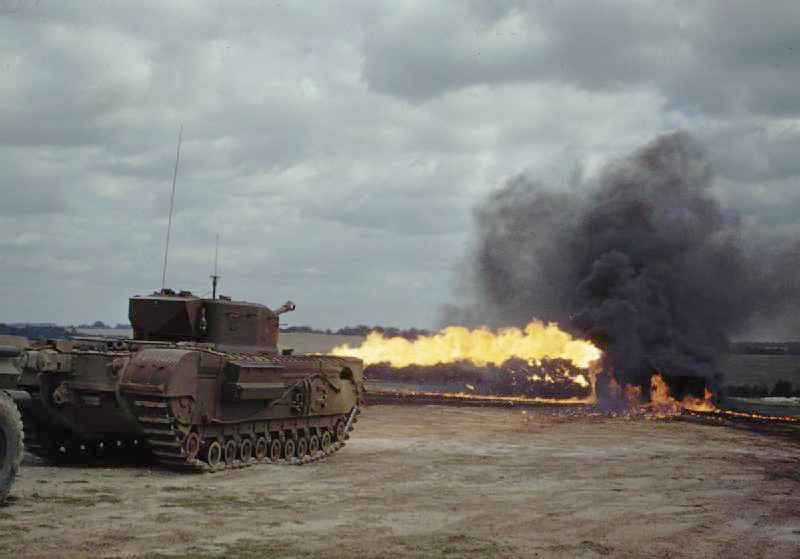
The Long and Controversial History of the Flamethrower
Whether it be flaming arrows, Greek Fire, torching villages, pouring boiling tar down on one’s enemies through castle murder holes or 20th century flamethrowers, incendiary shells and even the present day use of domestic petrol bombs in terror attacks – fire has been weaponised either as a means of attack or defence for millennia.
Quite possibly from the very beginnings of the human ability to harness this essential and yet feared element of nature. The fear of fire, or of burning to death is an ancient one. Its one not easily controlled by the Allied soldiers who were forced to face this terrifying German weapon.
As warfare has changed over time, so too has the use of fire. In ancient times before the advent of siege warfare, fire was used to force surrender by destroying people’s belongings. It would burn crops and homes.
In more recent history with the development of technologies it could be used to psychologically intimidate the enemy. This would force them to scatter and relinquish their defensive position.
This allowed ground to be gained with relatively little effort on the part of the attacking force. Much like ants fleeing in panic when their nest is targeted by a human wielding a kettle of boiling water!
The Development of Flamethrower Technology
Like any new technology, the flamethrower had its teething problems. This as with other advancements during World War One, the flamethrower evolved through several stages of development in a relatively short space of time.
The first man to be credited with its invention was German Engineer Richard Fiedler. His work inventing new nozzles for spraying various liquid substances gave rise to the concept of a portable fuel tank. This allowed fuel to be sprayed and ignited producing a terrifying jet of flame. He submitted his original design in 1901. It would not be until 1911 after the trial and error of several further prototypes, that the German army accepted the new flamethrowing device.
 An American soldier with flamethrower runs under fire in the Pacific. The Japanese feared this weapon immensely.
An American soldier with flamethrower runs under fire in the Pacific. The Japanese feared this weapon immensely.
Also involved in the conception of this effective modern weapon was former German fire chief, Bernhard Reddemann. He later be entrusted with the recruitment and training of the men who would operate the new weapon.
Rather ironically, he chose men from the firefighting profession. His reasoning for this was that these men understood fire and how it moves and spreads. It was also reasoned that they would be less daunted by the huge blaze produced by the new flamethrower technology.
The Flamethrowers of WW1
One, the Grocer Flammenwerfer, more popularly known as the ‘Grof’ was a substantial bit of kit. Measuring over 1 metre tall and featuring a large central fuel tank flanked by two nitrogen propellant tanks it weighed in at 75kg when full. Due to its size, it was only suitable for static use within trenches. It needed to be manned by a team of five men!
Despite these cons, it was a very powerful weapon burning for 40 seconds. It was capable of hitting a target at 36 metres (40 yards) away, no doubt inspiring utter terror for those who fell victim to it!
 German pioneers with flamethrowers during the First World War. They were cumbersome but effective.
German pioneers with flamethrowers during the First World War. They were cumbersome but effective.
Soon the demand was for a smaller, more portable flamethrower. The response was the development of the Kleine Flammenwerfer, also known as the ‘Klief’. Kleifs were carried on the back on one soldier. Another operated the tube to direct the 60ft flame at the enemy position. Though lighter than previous models, the Klief still weighed in at approximately 30kg.
Read More: WWI Trench Raiding Weapons
This design eventually gave way to the donut-shaped ‘Wex’ or Wechselappar. This was introduced later in 1916 to replace the earlier Kleif model.
This version went on to form the basis for a British flamethrower design adopted in WW2. It was designed to be worn on the back of a single operator. This made it far more practical in terms of mobility and manpower.
The drawbacks of the design lay largely in its limited capacity and usage. It only had an 11 litre fuel tank with a burn duration of just 9 seconds. This meant other soldiers had to carry spare fuel tanks which could be connected to the hose when one ran out.
This process was fiddly and impractical in practice. But as a working flamethrower which could be operated by one man, this design was an important step forwards. Besides its faults, its ability as a psychological deterrent far outweighed its practical inconveniences.
The Flamethrower in action
After the first minor engagements in 1914, a small number of flamethrower operators (as part of the Flammenwerfer Optilone under Reddemann’s command) had their first significant battlefield experience during the assault on the forest of Malancourt, North of Verdun on Feb 26th 1915.
The success of the attack lay not only in surprising the socks off the French but also in terrifying them so completely by the ferocity of the fire brought upon them, not to mention the thick, black burning clouds of toxic smoke the flamethrowers produced.
Like the earlier ant nest analogy, caught by the fire the French soldiers abandoned their posts in panic and ran straight towards the German rifles. Within minutes the French defence collapsed completely. The flamethrowers were the key to this particular battlefield success.
Successes such as this led Reddemann’s unit to form a flamethrower battalion under the patronage of Crown Prince Wilhelm. Then, platoons of flamethrower operators joined attachments of stormtroopers, going on to become a staple of German assault tactics throughout WW1.
 Flamethrowers became a staple feature of German assault tactics on the battlefields of WW1
Flamethrowers became a staple feature of German assault tactics on the battlefields of WW1
They were then expanded to the level of regiment becoming the guard reserve pioneer regiment, the principle flamethrower unit until the end of the war. For recognition of their contribution towards the German war effort the regiment was awarded a Totenkopf badge or ‘deaths-head’ badge on July 28th 1916.
War Horse: A Brief History of Horses on the Battlefield
Thereafter, flamethrower operators wore the ‘deaths-head’ badge on their left sleeve and became known as the Totenkopf Pioniere or Death’s Head Pioneers, one of the most feared units of the entire conflict.
Fame isn’t everything
However glorious all this recognition may sound their notoriety would be the very thing that caused the flamethrower operative to have the shortest life expectancy of any soldier on the battlefield.
Firstly, being a new technology, the flamethrower equipment was prone to develop problems. Gas cylinders would sometimes malfunction causing the pressure to decrease and the weapon to fail.
Secondly, because they were both so feared and hated by the Allied soldiers they became marked men. Whenever they appeared on the battlefield, heavy fire would be concentrated directly on them and if they were caught alive, they could expect absolutely no mercy from their captors.
Due to these issues, it was eventually realised that leaving a flamethrower team on their own made them extremely vulnerable targets, so infantry support was always required.
During the entirety of the Great War, flamethrower operators carried out over 600 attacks. Deployed primarily for their psychological impact with the support of an accompanying infantry unit, most enemy casualties came from the infantry fire that followed once soldiers were flushed out of the trenches by the threat of flame and smoke, rather than death by the actual flamethrower itself.
After the Great War
The German use of the flamethrower inspired other nations to keep up with the development of ever more new and devastating technologies, leading to extensive use in World War Two on all sides of the conflict.
The Americans were comparatively late to the flamethrowing game, not developing their own final version, the M2, until relatively late in World War Two. They felt the biggest failing of Fieldler’s flamethrower technology was that the fuel was not imbued with a thickening agent which would otherwise help it stick to its target causing further damage. This was resolved by the development of napalm which was then deployed with lethal effect by the aptly nicknamed battalion, The Hellfire Boys.
 A Churchill Crocodile in action. A Tank combined with a flamethrower was often enough for enemies to surrender. (IWM)
A Churchill Crocodile in action. A Tank combined with a flamethrower was often enough for enemies to surrender. (IWM)
The British had also made some developments of their own, among which was the Churchill Crocodile, a flamethrowing tank. This was equipped with a huge fuel tank filled with petrol and thickened with a petrol-based jelly substance. The tank-based flamethrower was crewed by a team of 5 and had a range of up to 120 yards!
The development of these ‘sticky’ fuels meant that the flamethrower as a weapon was now no longer used just to flush out the enemy. It was now designed to injure, burn and cause altogether more destruction. This increasing use was met with concern in Britain where flamethrowers were perceived to be “an inhuman projection of the German scientific mind.”
The use of napalm made the US portable flamethrower the M1 a devastatingly deadly weapon. Though it still functioned effectively as a weapon of psychological warfare, it was now more portable. It was able to be used with barbaric effect at close range as well. It was used extensively in the Korean War and later in the 1960s against the North Vietnamese.
Into the Jungle
During the Vietnam war the flamethrower had been further developed and the new version, the M9 was easier to carry. It had an incredible firing range of 60 metres.
This new flamethrower was being used more often at close range within bunkers or buildings earning it the name the ‘skin-steal’. The unpleasantly vivid image that this nickname conjures up is well justified. It certainly had the ability to melt the skin of those fighters unlucky enough to be on the receiving end. This concern was further supported by the appearance of images from the war featuring badly burned bodies.
 A U.S. marine in Da Nang firing a flamethrower during the Vietnam War. Deadly and demoralizing.
A U.S. marine in Da Nang firing a flamethrower during the Vietnam War. Deadly and demoralizing.
Initially the British were proposing restrictions be placed on the use of incendiary weapons intended to cause death by burning. Now in the US also there were voices speaking out about the extreme injuries and unnecessary suffering caused by the weapon. Any injury being sustained likely to take a long time to heal, be difficult to treat and cause long-term physical and mental damage to the victim.
There was also concern about the damage caused to the infrastructure and the environment. The fires produced by these modern flamethrowers with their sticky fuels were huge. They were difficult to predict and often caused damage well over and above the originally intended small target.
However, it was not until the 1960s and 70s that investigations were conducted into how painful and inhumane a death was caused by the weapons. Equally controversially these tests were carried out on a range of large animals. Ultimately this led to the discovery that death by flamethrower was not the ‘mercy killing’ its designers and operatives believed it to be.
Although flamethrowers are not fully banned by law, the Geneva Convention of 1980 restricted its use as a weapon which is “excessively injurious [with] indiscriminate effects.” Advancements in warfare have moved on since and weapon technology has moved along with it. However the flamethrower certainly remains one of the most terrifying creations in the history of thermal weaponry.
News
The Hanging Temple: China’s 1,500-Year-Old Cliffside Marvel of Faith and Engineering
The Hanging Temple: China’s 1,500-Year-Old Cliffside Marvel of Faith and Engineering Perched precariously on the cliffs of Mount Heng in Shanxi Province, China, the Hanging Temple, also known as Xuankong Temple, Hengshan Hanging Temple, or Hanging Monastery, is an architectural…
The Willendorf Venus: A 30,000-Year-Old Masterpiece Reveals Astonishing Secrets
The Willendorf Venus: A 30,000-Year-Old Masterpiece Reveals Astonishing Secrets The “Willendorf Venus” stands as one of the most revered archaeological treasures from the Upper Paleolithic era. Discovered in 1908 by scientist Johann Veran near Willendorf, Austria, this small yet profound…
Unveiling the Maya: Hallucinogens and Rituals Beneath the Yucatán Ball Courts
Unveiling the Maya: Hallucinogens and Rituals Beneath the Yucatán Ball Courts New archaeological research has uncovered intriguing insights into the ritual practices of the ancient Maya civilization. The focus of this study is a ceremonial offering found beneath the sediment…
Uncovering the Oldest Agricultural Machine: The Threshing Sledge’s Neolithic Origins
Uncovering the Oldest Agricultural Machine: The Threshing Sledge’s Neolithic Origins The history of agricultural innovation is a fascinating journey that spans thousands of years, and one of the earliest known agricultural machines is the threshing sledge. Recently, a groundbreaking study…
Nara’s Ancient Sword: A 1,600-Year-Old Protector Against Evil Spirits
Nara’s Ancient Sword: A 1,600-Year-Old Protector Against Evil Spirits In a remarkable discovery that has captured the attention of archaeologists and historians alike, a 7.5-foot-long iron sword was unearthed from a 1,600-year-old burial mound in Nara, Japan. This oversized weapon,…
The Inflatable Plane, Dropped Behind the Lines for Downed Pilots
Experimental The Inflatable Plane, Dropped Behind the Lines for Downed Pilots The Inflatoplane from Goodyear was an unconventional aircraft developed by the Goodyear Aircraft Company, a branch of the renowned Goodyear Tire and Rubber Company, also famed for the Goodyear…
End of content
No more pages to load











